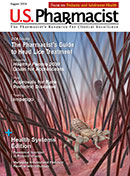In a recent study published in the International Journal of Chronic Obstructive Pulmonary Disease, researchers conducted a retrospective observational study and sought to obtain real-world data by investigating the impact of inhaled corticosteroids (ICS) on the prognosis of Asian patients with COPD.
The researchers wrote, "A comprehensive analysis of the effects of inhaled corticosteroids (ICS) on COPD in a real-world setting is required due to safety concerns regarding ICS in COPD."
The researchers utilized data from the Korean National Health and Nutrition Examination Survey (KNHANES) database. Primary outcomes were pneumonia, acute exacerbation, and mortality; secondary outcomes included tuberculosis, ischemic heart disease, cerebrovascular stroke, lung cancer, osteoporosis, diabetes mellitus, hypertension, arrhythmia, and heart failure.
The researchers assessed 978 patients with COPD registered in the KNHANES database and with their data linked to Health Insurance and Review Assessment data. The study participants were divided into two groups: ICS users (n = 85, average age = 66.7 ± 8.9 years) and non-ICS users (n = 893, average age = 63.7 ± 9.7 years).
The 85 eligible patients using ICS all had a prescription for inhaled respiratory medication for at least 120 days during the observation period and were recorded as 13 patients using ICS, 42 patients using ICS/long-acting beta-agonists (LABA), and 30 patients using ICS/LABA/long-acting muscarinic antagonist.
Cox proportional hazard regression analysis was employed to detect variables significantly correlated with the occurrence of mortality, acute exacerbation, and pneumonia development.
At study enrollment, common comorbidities documented included diabetes mellitus (12.2%), hypertension (33.2%), coronary artery disease (3.8%), myocardial infarction (1.6%), and cerebrovascular stroke (0.8%). The patients who used ICS had a higher number of smokers, lower EuroQol five-dimensions five-level (EQ-5D) score, and lower forced expiratory volume (FEV1) and FEV1/FVC (forced vital capacity) than non-ICS users.
The results revealed that when comparing ICS and non-ICS subjects, individuals who used ICS therapy had greater rates of pneumonia, tuberculosis, acute exacerbations (P <.05), and lung cancer. Hospitalization due to respiratory causes was also greater among ICS users (P <.05). Additionally, multivariate analysis revealed acute exacerbation was independently correlated with the development of pneumonia (P < .05), whereas ICS therapy had a propensity to be correlated with pneumonia.
Another multivariate analysis demonstrated that the occurrence of acute exacerbation (P <.05) was independently associated with old age, FEV1, ICS therapy, and pneumonia, and concomitant pneumonia (HR = 3.353, P = .004) was independently linked with higher mortality.
Based on their findings, the authors indicated, "Our study provides a comprehensive analysis of the clinical course of COPD in the light of the development of comorbidities according to ICS intervention."
With regard to one of the study limitations, the authors wrote, "The small number of ICS users (85 out of 978, 8.7%) is a limitation in the interpretation of our analysis, therefore this study cannot determine the causal link between ICS therapy and adverse events."
The authors wrote, "In conclusion, our data demonstrated that the ICS users had a higher rate of pneumonia and tuberculosis, and the concomitant pneumonia was independently associated with higher mortality, highlighting the importance of cautious and targeted administration of ICS in COPD."
The content contained in this article is for informational purposes only. The content is not intended to be a substitute for professional advice. Reliance on any information provided in this article is solely at your own risk.
« Click here to return to Respiratory Update.
Published June 12, 2023





